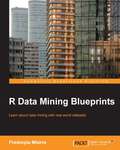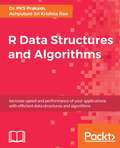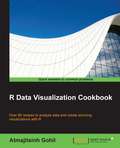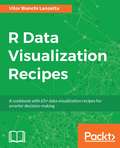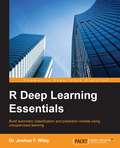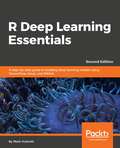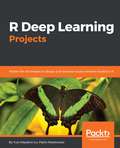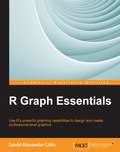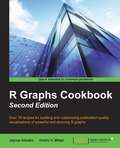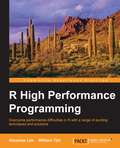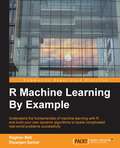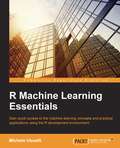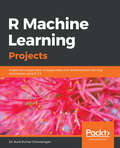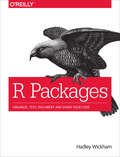- Table View
- List View
R Data Mining Blueprints
by Pradeepta MishraLearn about data mining with real-world datasets About This Book * Diverse real-world datasets to teach data mining techniques * Practical and focused on real-world data mining cases, this book covers concepts such as spatial data mining, text mining, social media mining, and web mining * Real-world case studies illustrate various data mining techniques, taking you from novice to intermediate Who This Book Is For Data analysts from beginner to intermediate level who need a step-by-step helping hand in developing complex data mining projects are the ideal audience for this book. They should have prior knowledge of basic statistics and little bit of programming language experience in any tool or platform. What You Will Learn * Make use of statistics and programming to learn data mining concepts and its applications * Use R Programming to apply statistical models on data * Create predictive models to be applied for performing classification, prediction and recommendation * Use of various libraries available on R CRAN (comprehensive R archives network) in data mining * Apply data management steps in handling large datasets * Learn various data visualization libraries available in R for representing data * Implement various dimension reduction techniques to handle large datasets * Acquire knowledge about neural network concept drawn from computer science and its applications in data mining In Detail The R language is a powerful open source functional programming language. At its core, R is a statistical programming language that provides impressive tools for data mining and analysis. It enables you to create high-level graphics and offers an interface to other languages. This means R is best suited to produce data and visual analytics through customization scripts and commands, instead of the typical statistical tools that provide tick boxes and drop-down menus for users. This book explores data mining techniques and shows you how to apply different mining concepts to various statistical and data applications in a wide range of fields. We will teach you about R and its application to data mining, and give you relevant and useful information you can use to develop and improve your applications. It will help you complete complex data mining cases and guide you through handling issues you might encounter during projects. Style and approach This fast-paced guide will help you solve predictive modeling problems using the most popular data mining algorithms through simple, practical cases.
R Data Science Essentials
by Sharan Kumar Ravindran Raja B. KoushikLearn the essence of data science and visualization using R in no time at allAbout This BookBecome a pro at making stunning visualizations and dashboards quickly and without hassleFor better decision making in business, apply the R programming language with the help of useful statistical techniques.From seasoned authors comes a book that offers you a plethora of fast-paced techniques to detect and analyze data patternsWho This Book Is ForIf you are an aspiring data scientist or analyst who has a basic understanding of data science and has basic hands-on experience in R or any other analytics tool, then R Data Science Essentials is the book for you.What You Will LearnPerform data preprocessing and basic operations on dataImplement visual and non-visual implementation data exploration techniquesMine patterns from data using affinity and sequential analysisUse different clustering algorithms and visualize themImplement logistic and linear regression and find out how to evaluate and improve the performance of an algorithmExtract patterns through visualization and build a forecasting algorithmBuild a recommendation engine using different collaborative filtering algorithmsMake a stunning visualization and dashboard using ggplot and R shinyIn DetailWith organizations increasingly embedding data science across their enterprise and with management becoming more data-driven it is an urgent requirement for analysts and managers to understand the key concept of data science. The data science concepts discussed in this book will help you make key decisions and solve the complex problems you will inevitably face in this new world.R Data Science Essentials will introduce you to various important concepts in the field of data science using R. We start by reading data from multiple sources, then move on to processing the data, extracting hidden patterns, building predictive and forecasting models, building a recommendation engine, and communicating to the user through stunning visualizations and dashboards.By the end of this book, you will have an understanding of some very important techniques in data science, be able to implement them using R, understand and interpret the outcomes, and know how they helps businesses make a decision.Style and approachThis easy-to-follow guide contains hands-on examples of the concepts of data science using R.
R Data Science Quick Reference: A Pocket Guide to APIs, Libraries, and Packages
by Thomas MailundIn this handy, practical book you will cover each concept concisely, with many illustrative examples. You'll be introduced to several R data science packages, with examples of how to use each of them. In this book, you’ll learn about the following APIs and packages that deal specifically with data science applications: readr, dibble, forecasts, lubridate, stringr, tidyr, magnittr, dplyr, purrr, ggplot2, modelr, and more.After using this handy quick reference guide, you'll have the code, APIs, and insights to write data science-based applications in the R programming language. You'll also be able to carry out data analysis. What You Will LearnImport data with readrWork with categories using forcats, time and dates with lubridate, and strings with stringrFormat data using tidyr and then transform that data using magrittr and dplyrWrite functions with R for data science, data mining, and analytics-based applicationsVisualize data with ggplot2 and fit data to models using modelrWho This Book Is ForProgrammers new to R's data science, data mining, and analytics packages. Some prior coding experience with R in general is recommended.
R Data Structures and Algorithms
by Achyutuni Sri Rao Dr Pks PrakashIncrease speed and performance of your applications with efficient data structures and algorithms About This Book * See how to use data structures such as arrays, stacks, trees, lists, and graphs through real-world examples * Find out about important and advanced data structures such as searching and sorting algorithms * Understand important concepts such as big-o notation, dynamic programming, and functional data structured Who This Book Is For This book is for R developers who want to use data structures efficiently. Basic knowledge of R is expected. What You Will Learn * Understand the rationality behind data structures and algorithms * Understand computation evaluation of a program featuring asymptotic and empirical algorithm analysis * Get to know the fundamentals of arrays and linked-based data structures * Analyze types of sorting algorithms * Search algorithms along with hashing * Understand linear and tree-based indexing * Be able to implement a graph including topological sort, shortest path problem, and Prim's algorithm * Understand dynamic programming (Knapsack) and randomized algorithms In Detail In this book, we cover not only classical data structures, but also functional data structures. We begin by answering the fundamental question: why data structures? We then move on to cover the relationship between data structures and algorithms, followed by an analysis and evaluation of algorithms. We introduce the fundamentals of data structures, such as lists, stacks, queues, and dictionaries, using real-world examples. We also cover topics such as indexing, sorting, and searching in depth. Later on, you will be exposed to advanced topics such as graph data structures, dynamic programming, and randomized algorithms. You will come to appreciate the intricacies of high performance and scalable programming using R. We also cover special R data structures such as vectors, data frames, and atomic vectors. With this easy-to-read book, you will be able to understand the power of linked lists, double linked lists, and circular linked lists. We will also explore the application of binary search and will go in depth into sorting algorithms such as bubble sort, selection sort, insertion sort, and merge sort. Style and approach This easy-to-read book with its fast-paced nature will improve the productivity of an R programmer and improve the performance of R applications. It is packed with real-world examples.
R Data Visualization Cookbook
by Atmajitsinh GohilIf you are a data journalist, academician, student or freelance designer who wants to learn about data visualization, this book is for you. Basic knowledge of R programming is expected.
R Data Visualization Recipes
by Vitor Bianchi LanzettaTranslate your data into info-graphics using popular packages in R About This Book • Use R's popular packages—such as ggplot2, ggvis, ggforce, and more—to create custom, interactive visualization solutions. • Create, design, and build interactive dashboards using Shiny • A highly practical guide to help you get to grips with the basics of data visualization techniques, and how you can implement them using R Who This Book Is For If you are looking to create custom data visualization solutions using the R programming language and are stuck somewhere in the process, this book will come to your rescue. Prior exposure to packages such as ggplot2 would be useful but not necessary. However, some R programming knowledge is required. What You Will Learn • Get to know various data visualization libraries available in R to represent data • Generate elegant codes to craft graphics using ggplot2, ggvis and plotly • Add elements, text, animation, and colors to your plot to make sense of data • Deepen your knowledge by adding bar-charts, scatterplots, and time series plots using ggplot2 • Build interactive dashboards using Shiny. • Color specific map regions based on the values of a variable in your data frame • Create high-quality journal-publishable scatterplots • Create and design various three-dimensional and multivariate plots In Detail R is an open source language for data analysis and graphics that allows users to load various packages for effective and better data interpretation. Its popularity has soared in recent years because of its powerful capabilities when it comes to turning different kinds of data into intuitive visualization solutions. This book is an update to our earlier R data visualization cookbook with 100 percent fresh content and covering all the cutting edge R data visualization tools. This book is packed with practical recipes, designed to provide you with all the guidance needed to get to grips with data visualization using R. It starts off with the basics of ggplot2, ggvis, and plotly visualization packages, along with an introduction to creating maps and customizing them, before progressively taking you through various ggplot2 extensions, such as ggforce, ggrepel, and gganimate. Using real-world datasets, you will analyze and visualize your data as histograms, bar graphs, and scatterplots, and customize your plots with various themes and coloring options. The book also covers advanced visualization aspects such as creating interactive dashboards using Shiny By the end of the book, you will be equipped with key techniques to create impressive data visualizations with professional efficiency and precision. Style and approach This book is packed with practical recipes, designed to provide you with all the guidance needed to get to grips with data visualization with R. You will learn to leverage the power of R and ggplot2 to create highly customizable data visualizations of varying complexities. The readers will then learn how to create, design, and build interactive dashboards using Shiny.
R Deep Learning Cookbook
by Achyutuni Sri Rao Dr Pks PrakashPowerful, independent recipes to build deep learning models in different application areas using R libraries About This Book • Master intricacies of R deep learning packages such as mxnet & tensorflow • Learn application on deep learning in different domains using practical examples from text, image and speech • Guide to set-up deep learning models using CPU and GPU Who This Book Is For Data science professionals or analysts who have performed machine learning tasks and now want to explore deep learning and want a quick reference that could address the pain points while implementing deep learning. Those who wish to have an edge over other deep learning professionals will find this book quite useful. What You Will Learn • Build deep learning models in different application areas using TensorFlow, H2O, and MXnet. • Analyzing a Deep boltzmann machine • Setting up and Analysing Deep belief networks • Building supervised model using various machine learning algorithms • Set up variants of basic convolution function • Represent data using Autoencoders. • Explore generative models available in Deep Learning. • Discover sequence modeling using Recurrent nets • Learn fundamentals of Reinforcement Leaning • Learn the steps involved in applying Deep Learning in text mining • Explore application of deep learning in signal processing • Utilize Transfer learning for utilizing pre-trained model • Train a deep learning model on a GPU In Detail Deep Learning is the next big thing. It is a part of machine learning. It's favorable results in applications with huge and complex data is remarkable. Simultaneously, R programming language is very popular amongst the data miners and statisticians. This book will help you to get through the problems that you face during the execution of different tasks and Understand hacks in deep learning, neural networks, and advanced machine learning techniques. It will also take you through complex deep learning algorithms and various deep learning packages and libraries in R. It will be starting with different packages in Deep Learning to neural networks and structures. You will also encounter the applications in text mining and processing along with a comparison between CPU and GPU performance. By the end of the book, you will have a logical understanding of Deep learning and different deep learning packages to have the most appropriate solutions for your problems. Style and approach Collection of hands-on recipes that would act as your all-time reference for your deep learning needs
R Deep Learning Essentials
by Dr Joshua WileyThis book caters to aspiring data scientists who are well versed with machine learning concepts with R and are looking to explore the deep learning paradigm using the packages available in R. You should have a fundamental understanding of the R language and be comfortable with statistical algorithms and machine learning techniques, but you do not need to be well versed with deep learning concepts.
R Deep Learning Essentials: A step-by-step guide to building deep learning models using TensorFlow, Keras, and MXNet, 2nd Edition
by Joshua F. Wiley Mark HodnettImplement neural network models in R 3.5 using TensorFlow, Keras, and MXNetKey FeaturesUse R 3.5 for building deep learning models for computer vision and textApply deep learning techniques in cloud for large-scale processingBuild, train, and optimize neural network models on a range of datasetsBook DescriptionDeep learning is a powerful subset of machine learning that is very successful in domains such as computer vision and natural language processing (NLP). This second edition of R Deep Learning Essentials will open the gates for you to enter the world of neural networks by building powerful deep learning models using the R ecosystem.This book will introduce you to the basic principles of deep learning and teach you to build a neural network model from scratch. As you make your way through the book, you will explore deep learning libraries, such as Keras, MXNet, and TensorFlow, and create interesting deep learning models for a variety of tasks and problems, including structured data, computer vision, text data, anomaly detection, and recommendation systems. You’ll cover advanced topics, such as generative adversarial networks (GANs), transfer learning, and large-scale deep learning in the cloud. In the concluding chapters, you will learn about the theoretical concepts of deep learning projects, such as model optimization, overfitting, and data augmentation, together with other advanced topics.By the end of this book, you will be fully prepared and able to implement deep learning concepts in your research work or projects.What you will learnBuild shallow neural network prediction modelsPrevent models from overfitting the data to improve generalizabilityExplore techniques for finding the best hyperparameters for deep learning modelsCreate NLP models using Keras and TensorFlow in RUse deep learning for computer vision tasksImplement deep learning tasks, such as NLP, recommendation systems, and autoencodersWho this book is forThis second edition of R Deep Learning Essentials is for aspiring data scientists, data analysts, machine learning developers, and deep learning enthusiasts who are well versed in machine learning concepts and are looking to explore the deep learning paradigm using R. Fundamental understanding of the R language is necessary to get the most out of this book.
R Deep Learning Projects: Master the techniques to design and develop neural network models in R
by Yuxi Hayden Liu Pablo Maldonado5 real-world projects to help you master deep learning concepts Key Features Master the different deep learning paradigms and build real-world projects related to text generation, sentiment analysis, fraud detection, and more Get to grips with R's impressive range of Deep Learning libraries and frameworks such as deepnet, MXNetR, Tensorflow, H2O, Keras, and text2vec Practical projects that show you how to implement different neural networks with helpful tips, tricks, and best practices Book Description R is a popular programming language used by statisticians and mathematicians for statistical analysis, and is popularly used for deep learning. Deep Learning, as we all know, is one of the trending topics today, and is finding practical applications in a lot of domains. This book demonstrates end-to-end implementations of five real-world projects on popular topics in deep learning such as handwritten digit recognition, traffic light detection, fraud detection, text generation, and sentiment analysis. You'll learn how to train effective neural networks in R—including convolutional neural networks, recurrent neural networks, and LSTMs—and apply them in practical scenarios. The book also highlights how neural networks can be trained using GPU capabilities. You will use popular R libraries and packages—such as MXNetR, H2O, deepnet, and more—to implement the projects. By the end of this book, you will have a better understanding of deep learning concepts and techniques and how to use them in a practical setting. What you will learn - Instrument Deep Learning models with packages such as deepnet, MXNetR, Tensorflow, H2O, Keras, and text2vec - Apply neural networks to perform handwritten digit recognition using MXNet - Get the knack of CNN models, Neural Network API, Keras, and TensorFlow for traffic sign classification -Implement credit card fraud detection with Autoencoders -Master reconstructing images using variational autoencoders - Wade through sentiment analysis from movie reviews - Run from past to future and vice versa with bidirectional Long Short-Term Memory (LSTM) networks - Understand the applications of Autoencoder Neural Networks in clustering and dimensionality reductionWho this book is for Machine learning professionals and data scientists looking to master deep learning by implementing practical projects in R will find this book a useful resource. A knowledge of R programming and the basic concepts of deep learning is required to get the best out of this book.
R For Dummies
by Joris Meys Andrie De VriesMaster the programming language of choice among statisticians and data analysts worldwideComing to grips with R can be tough, even for seasoned statisticians and data analysts. Enter R For Dummies, the quick, easy way to master all the R you'll ever need. Requiring no prior programming experience and packed with practical examples, easy, step-by-step exercises, and sample code, this extremely accessible guide is the ideal introduction to R for complete beginners. It also covers many concepts that intermediate-level programmers will find extremely useful.Master your R ABCs ? get up to speed in no time with the basics, from installing and configuring R to writing simple scripts and performing simultaneous calculations on many variables Put data in its place ? get to know your way around lists, data frames, and other R data structures while learning to interact with other programs, such as Microsoft Excel Make data dance to your tune ? learn how to reshape and manipulate data, merge data sets, split and combine data, perform calculations on vectors and arrays, and much more Visualize it ? learn to use R's powerful data visualization features to create beautiful and informative graphical presentations of your data Get statistical ? find out how to do simple statistical analysis, summarize your variables, and conduct classic statistical tests, such as t-tests Expand and customize R ? get the lowdown on how to find, install, and make the most of add-on packages created by the global R community for a wide variety of purposesOpen the book and find:Help downloading, installing, and configuring RTips for getting data in and out of RWays to use data frames and lists to organize dataHow to manipulate and process dataAdvice on fitting regression models and ANOVAHelpful hints for working with graphicsHow to code in RWhat R mailing lists and forums can do for you
R For Dummies
by Joris Meys Andrie de VriesMaster the programming language of choice among statisticians and data analysts worldwide Coming to grips with R can be tough, even for seasoned statisticians and data analysts. Enter R For Dummies, the quick, easy way to master all the R you'll ever need. Requiring no prior programming experience and packed with practical examples, easy, step-by-step exercises, and sample code, this extremely accessible guide is the ideal introduction to R for complete beginners. It also covers many concepts that intermediate-level programmers will find extremely useful. Master your R ABCs ? get up to speed in no time with the basics, from installing and configuring R to writing simple scripts and performing simultaneous calculations on many variables Put data in its place ? get to know your way around lists, data frames, and other R data structures while learning to interact with other programs, such as Microsoft Excel Make data dance to your tune ? learn how to reshape and manipulate data, merge data sets, split and combine data, perform calculations on vectors and arrays, and much more Visualize it ? learn to use R's powerful data visualization features to create beautiful and informative graphical presentations of your data Get statistical ? find out how to do simple statistical analysis, summarize your variables, and conduct classic statistical tests, such as t-tests Expand and customize R ? get the lowdown on how to find, install, and make the most of add-on packages created by the global R community for a wide variety of purposes Open the book and find: Help downloading, installing, and configuring R Tips for getting data in and out of R Ways to use data frames and lists to organize data How to manipulate and process data Advice on fitting regression models and ANOVA Helpful hints for working with graphics How to code in R What R mailing lists and forums can do for you
R For Marketing Research and Analytics (Use R!)
by Chris Chapman Elea McDonnell FeitThe 2nd edition of R for Marketing Research and Analytics continues to be the best place to learn R for marketing research. This book is a complete introduction to the power of R for marketing research practitioners. The text describes statistical models from a conceptual point of view with a minimal amount of mathematics, presuming only an introductory knowledge of statistics. Hands-on chapters accelerate the learning curve by asking readers to interact with R from the beginning. Core topics include the R language, basic statistics, linear modeling, and data visualization, which is presented throughout as an integral part of analysis.Later chapters cover more advanced topics yet are intended to be approachable for all analysts. These sections examine logistic regression, customer segmentation, hierarchical linear modeling, market basket analysis, structural equation modeling, and conjoint analysis in R. The text uniquely presents Bayesian models with a minimally complex approach, demonstrating and explaining Bayesian methods alongside traditional analyses for analysis of variance, linear models, and metric and choice-based conjoint analysis. With its emphasis on data visualization, model assessment, and development of statistical intuition, this book provides guidance for any analyst looking to develop or improve skills in R for marketing applications.The 2nd edition increases the book’s utility for students and instructors with the inclusion of exercises and classroom slides. At the same time, it retains all of the features that make it a vital resource for practitioners: non-mathematical exposition, examples modeled on real world marketing problems, intuitive guidance on research methods, and immediately applicable code.
R Graph Cookbook
by Hrishi V. MittalThis hands-on guide cuts short the preamble and gets straight to the point - actually creating graphs, instead of just theoretical learning. Each recipe is specifically tailored to fulfill your appetite for visually representing you data in the best way possible. This book is for readers already familiar with the basics of R who want to learn the best techniques and code to create graphics in R in the best way possible. It will also serve as an invaluable reference book for expert R users.
R Graph Essentials
by David Alexander LillisThis book is targeted at R programmers who want to learn the graphing capabilities of R. This book will presume that you have working knowledge of R.
R Graphics Cookbook: Practical Recipes for Visualizing Data
by Winston ChangThis practical guide provides more than 150 recipes to help you generate high-quality graphs quickly, without having to comb through all the details of R’s graphing systems. Each recipe tackles a specific problem with a solution you can apply to your own project, and includes a discussion of how and why the recipe works.Most of the recipes use the ggplot2 package, a powerful and flexible way to make graphs in R. If you have a basic understanding of the R language, you’re ready to get started.Use R’s default graphics for quick exploration of dataCreate a variety of bar graphs, line graphs, and scatter plotsSummarize data distributions with histograms, density curves, box plots, and other examplesProvide annotations to help viewers interpret dataControl the overall appearance of graphicsRender data groups alongside each other for easy comparisonUse colors in plotsCreate network graphs, heat maps, and 3D scatter plotsStructure data for graphing
R Graphics Cookbook: Practical Recipes for Visualizing Data
by Winston ChangThis O’Reilly cookbook provides more than 150 recipes to help scientists, engineers, programmers, and data analysts generate high-quality graphs quickly—without having to comb through all the details of R’s graphing systems. Each recipe tackles a specific problem with a solution you can apply to your own project and includes a discussion of how and why the recipe works.Most of the recipes in this second edition use the updated version of the ggplot2 package, a powerful and flexible way to make graphs in R. You’ll also find expanded content about the visual design of graphics. If you have at least a basic understanding of the R language, you’re ready to get started with this easy-to-use reference.Use R’s default graphics for quick exploration of dataCreate a variety of bar graphs, line graphs, and scatter plotsSummarize data distributions with histograms, density curves, box plots, and moreProvide annotations to help viewers interpret dataControl the overall appearance of graphicsExplore options for using colors in plotsCreate network graphs, heat maps, and 3D scatter plotsGet your data into shape using packages from the tidyverse
R Graphics, Third Edition (Chapman & Hall/CRC The R Series)
by Paul MurrellThis third edition of Paul Murrell’s classic book on using R for graphics represents a major update, with a complete overhaul in focus and scope. It focuses primarily on the two core graphics packages in R - graphics and grid - and has a new section on integrating graphics. This section includes three new chapters: importing external images in to R; integrating the graphics and grid systems; and advanced SVG graphics.The emphasis in this third edition is on having the ability to produce detailed and customised graphics in a wide variety of formats, on being able to share and reuse those graphics, and on being able to integrate graphics from multiple systems.This book is aimed at all levels of R users. For people who are new to R, this book provides an overview of the graphics facilities, which is useful for understanding what to expect from R's graphics functions and how to modify or add to the output they produce. For intermediate-level R users, this book provides all of the information necessary to perform sophisticated customizations of plots produced in R. For advanced R users, this book contains vital information for producing coherent, reusable, and extensible graphics functions.
R Graphs Cookbook Second Edition
by Jaynal Abedin Hrishi V. MittalTargeted at those with an existing familiarity with R programming, this practical guide will appeal directly to programmers interested in learning effective data visualization techniques with R and a wide-range of its associated libraries.
R High Performance Programming
by William Tjhi Aloysius LimThis book is for programmers and developers who want to improve the performance of their R programs by making them run faster with large data sets or who are trying to solve a pesky performance problem.
R Machine Learning By Example
by Raghav Bali Dipanjan SarkarUnderstand the fundamentals of machine learning with R and build your own dynamic algorithms to tackle complicated real-world problems successfully About This Book * Get to grips with the concepts of machine learning through exciting real-world examples * Visualize and solve complex problems by using power-packed R constructs and its robust packages for machine learning * Learn to build your own machine learning system with this example-based practical guide Who This Book Is For If you are interested in mining useful information from data using state-of-the-art techniques to make data-driven decisions, this is a go-to guide for you. No prior experience with data science is required, although basic knowledge of R is highly desirable. Prior knowledge in machine learning would be helpful but is not necessary. What You Will Learn * Utilize the power of R to handle data extraction, manipulation, and exploration techniques * Use R to visualize data spread across multiple dimensions and extract useful features * Explore the underlying mathematical and logical concepts that drive machine learning algorithms * Dive deep into the world of analytics to predict situations correctly * Implement R machine learning algorithms from scratch and be amazed to see the algorithms in action * Write reusable code and build complete machine learning systems from the ground up * Solve interesting real-world problems using machine learning and R as the journey unfolds * Harness the power of robust and optimized R packages to work on projects that solve real-world problems in machine learning and data science In Detail Data science and machine learning are some of the top buzzwords in the technical world today. From retail stores to Fortune 500 companies, everyone is working hard to making machine learning give them data-driven insights to grow their business. With powerful data manipulation features, machine learning packages, and an active developer community, R empowers users to build sophisticated machine learning systems to solve real-world data problems. This book takes you on a data-driven journey that starts with the very basics of R and machine learning and gradually builds upon the concepts to work on projects that tackle real-world problems. You'll begin by getting an understanding of the core concepts and definitions required to appreciate machine learning algorithms and concepts. Building upon the basics, you will then work on three different projects to apply the concepts of machine learning, following current trends and cover major algorithms as well as popular R packages in detail. These projects have been neatly divided into six different chapters covering the worlds of e-commerce, finance, and social-media, which are at the very core of this data-driven revolution. Each of the projects will help you to understand, explore, visualize, and derive insights depending upon the domain and algorithms. Through this book, you will learn to apply the concepts of machine learning to deal with data-related problems and solve them using the powerful yet simple language, R. Style and approach The book is an enticing journey that starts from the very basics to gradually pick up pace as the story unfolds. Each concept is first defined in the larger context of things succinctly, followed by a detailed explanation of their application. Each topic is explained with the help of a project that solves a real real-world problem involving hands-on work thus giving you a deep insight into the world of machine learning.
R Machine Learning Essentials
by Michele UsuelliIf you want to learn how to develop effective machine learning solutions to your business problems in R, this book is for you. It would be helpful to have a bit of familiarity with basic object-oriented programming concepts, but no prior experience is required.
R Machine Learning Projects: Implement Supervised, Unsupervised, And Reinforcement Learning Techniques Using R 3. 5
by Sunil Kumar ChinnamgariThis book is for data analysts, data scientists, and machine learning developers who wish to master the machine learning concepts using R by building real-world projects. Each project will help you test your expertise to implement the working mechanism of machine learning algorithms and techniques. A basic understanding of machine learning and working knowledge of R programming is a must.
R Object-oriented Programming
by Kelly BlackThis book is designed for people with some experience in basic programming practices. It is also assumed that they have some basic experience using R and are familiar using the command line in an R environment. Our primary goal is to raise a beginner to a more advanced level to make him/her more comfortable creating programs and extending R to solve common problems.
R Packages
by Hadley WickhamTurn your R code into packages that others can easily download and use. This practical book shows you how to bundle reusable R functions, sample data, and documentation together by applying author Hadley Wickham's package development philosophy. In the process, you'll work with devtools, roxygen, and testthat, a set of R packages that automate common development tasks. Devtools encapsulates best practices that Hadley has learned from years of working with this programming language.Ideal for developers, data scientists, and programmers with various backgrounds, this book starts you with the basics and shows you how to improve your package writing over time. You'll learn to focus on what you want your package to do, rather than think about package structure.Learn about the most useful components of an R package, including vignettes and unit testsAutomate anything you can, taking advantage of the years of development experience embodied in devtoolsGet tips on good style, such as organizing functions into filesStreamline your development process with devtoolsLearn the best way to submit your package to the Comprehensive R Archive Network (CRAN)Learn from a well-respected member of the R community who created 30 R packages, including ggplot2, dplyr, and tidyr
